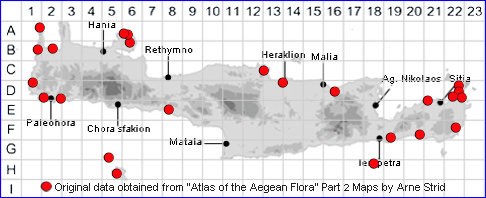SPECIES DESCRIPTION
LIMONIUM PROLIFERUM
Including For notes on the following species Click here
Limonium crateriforme,
Limonium recticaule.
Limonium stenotatum.
Family:- PLUMBAGINACEAE
Common Names:- None
Synonyms:- Statice prolifera
Meaning:- Limonium (Gr) Meadow-plant. A name used by the Greek physician
and botanist Dioscorides.
Proliferum (L) Proliferous, producing bunched growth or offsets or
young plantlets.
General description:- Glabrous, perennial, forming a sub-shrub 10-35 cm tall, with
many erect stems and a robust tap-root.
Caudices:-
1) 2-15 cm long.
2) Densely branched and densely spirally leafy in the upper half.
3) Sometimes leaves in rosettes at the apices.
Stems:-
1) 7-30 cm long.
2) Tuberculate with many crateriform glands.
3) Glaucous, conspicuously flexuous. much branched.
4) Sterile branches numerous, 0.5-5.0 cm long.
5) Fertile branches
a) numerous, glaucous.
b) tuberculate with many crateriform glands.
c) 1-6 cm long.
Leaves:-
1) Fleshy, rigid, glaucous, tuberculate with many crateriform glands.
2) 10-30 mm long x 4-8 mm broad.
3) Spathulate, apex obtuse.
4) Often v-shaped in cross-section.
5) Gradually tapering into the petiole.
Flowers:-
1) Spikes 10-50 mm long, arched, inserted erect to obliquely.
2) Spikelets 7.2-9.5 mm long, composed of 1-5 flowers.
3) Outer bract 2.2-3.0 mm long x 2.2-2.6 mm broad, triangular-ovate, obtuse to
rounded.
4) Middle bract membranous, 2.7-3.1 mm long x 2.0-2.5 mm broad, elliptic to
oblong-elliptic.
5) Inner bract 6.3-7.3 mm long x 4.2-5.0 mm broad, oblong-obovate, rounded
6) Calyx 6-7 mm long, exceeding the inner bract by 1-2 mm.
a) calyx tube sparsely to densely more or less long hairy.
b) calyx lobes very fine, ca. 0.5 x 1.1 mm, semi-circular.
7) Corolla pink to lilac.
Click here for a more detailed description of this species.
Habitat:- Rocky and sandy coastal habitats, rarely in dry open shrubby vegetation
a short distance inland. 0-50 m.
Distribution:- Central and southern Aegean region. Limited distribution on Crete
Flowering time:- May-Aug.
Photo by:- Fotis Samaritakis
FAMILY AND GENUS DESCRIPTIONS
PLUMBAGINACEAE
General description:- Herbs or shrubs.
Leaves:- Alternate or in basal rosettes, exstipulate.
Flowers:- Inflorescence usually cymose, often contracted into a capitulum, rarely
spike-like. Flowers actinomorphic, 5-merous, usually in bracteate spikelets. Calyx
tubular below, toothed (dentate) or lobed and at least slightly thin and dry (scarious)
and often pleated (plicate) distally, persistent. Petals united (connate) only at the
base, or the corolla with a usually short tube. Stamens united with the petals
(epipetalous). Styles 5, or 1 with 5 stigma-lobes. Ovary superior, 1-locular.
Fruit:- Dry, membranous, 1-seeded, surrounded by calyx, not splitting open to
release their seeds (indehiscent) or with circumscissile or irregular dehiscence.
LIMONIUM
General description:- Perennial, rarely annual, herbs or dwarf shrubs.
Leaves:- Simple, usually in a basal rosette, but densely leafy branches sometimes
present; leaves often absent at anthesis.
Flowers:- Inflorescence a corymbose panicle, with terminal, secund spikes, often
with non-flowering branches, usually with a reddish scale at the base of each
branch. Spikes of 3-bracteate, 1- to 5-flowered spikelets; inner and outer bracts
external to the spikelet, the middle one internal and often inconspicuous. Calyx
funnel-shaped (infundibuliform); limb thin and dry (scarious), usually coloured,
sometimes shortly dentate between the lobes. Corolla with a short tube, or the
petals united (connate) only at the base. Stamens inserted at the base of the
corolla. Styles 5, glabrous, free or connate at the base; stigmas thread-like
(filiform).
Fruit:- With circumscissile (opening by a slit running around the circumference) or
irregular splitting open to release the seeds (dehiscence).
1) Calyx infundibuliform.
2) Stamens inserted in base of corolla.
3) Styles 5, free or connate in basal half.
4) Fruit circumscissile towards apex or with irregular dehiscence.
5) Corolla-tube much shorter than lobes.
6) Spikes secund, the terminal not distinctly larger.
7) Stigmas filiform.

Arne Strid in his book "Atlas of the Aegean Flora" 2016.makes the following comments
Click on highlighted species for more information.
L. crateriforme, Erben & Brullo, ined., L. recticaule, Erben & Brullo, ined. and L. thirae Erben & Brullo, ined. are other local “species” said to be closely related to
L. proliferum and L. stenotatum. None of them can be clearly separated from
L. roridum
Click on highlighted species for more information.
L. crateriforme, Erben & Brullo, ined., L. recticaule, Erben & Brullo, ined. and L. thirae Erben & Brullo, ined. are other local “species” said to be closely related to
L. proliferum and L. stenotatum. None of them can be clearly separated from
L. roridum